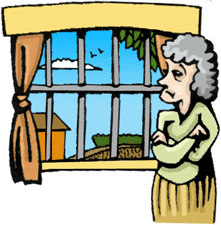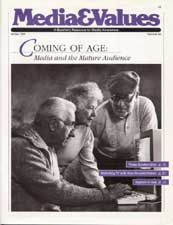Lifeline or Leisure?: TV's Role in the Lives of the Elderly
|
This article originally appeared in Issue# 45
|
Research Shows TV Plays Varied Roles in Seniors' Lives
In living rooms across the nation, we are told, listless seniors sit staring at TVs, trapped by loneliness and the fear that the world outside is mean and devoid of compassion. The stereotype is sad, but it is also one that is widely accepted as another sign of society's disintegration.
A decade ago, cartoonist Jules Feiffer drew a bead on the problem, penning a strip in which an older man sits talking to his TV.
"No one loves me," he says, and the TV responds, "I love you."
Each time the man complains that he has no one to take care of him, to give to him, or to be his friend, the TV assures him that he is not alone.
Dismayed at his reliance on an electronic gadget, the man says, "I can't go through life entirely dependent on television."
"Could you survive without me?" asks the TV. "But," questions the man, "is that enough?"
"That's show business," the TV glibly concludes.
Feiffer's talent prompts a laugh. But to what degree is this scenario a true reflection of our older population? Are the majority of America's senior citizens really couch potatoes who, having little else to turn to, accept with gratitude whatever TV offers them?
Fortunately, the answer is no. Research I conducted with Garrett J. O'Keefe of the University of Wisconsin/Madison, shows the older generation to be a highly diverse group with eclectic media needs and patterns of usage.
Those that work closely with our older citizens know that often the only thing seniors have in common is their age range, and sometimes even that doesn't count for much.
A single historical event — the Depression, for example — can have a dramatic impact on one's world view, with effects lasting a lifetime. That can mean a vast difference in outlook and lifestyle between someone who embarked on married life in 1929 compared with another of today's seniors who was an infant when the stock market crashed.
Window on the World
Research shows us that TV viewing does increase after age 55 - although all media usage, including television, decreases among the oldest members of society,  those over age 84. It seems that for the younger old, at least, TV is an important window to the world and a basis for shared experience for seniors.
those over age 84. It seems that for the younger old, at least, TV is an important window to the world and a basis for shared experience for seniors.
While many of today's elderly are housebound by health or limited resources and some certainly fit the unhappy stereotype described above, countless others are as highly mobile and as active as they wish to be.
As the number of seniors has increased, so has their diversity in terms of health, education, income, entertainment and information needs, and lifestyle. The increased diversity means that one cannot generalize about this age group's use of media because its members' choices are predicated on individual abilities and interests.
Implicit in the couch potato stereotype is the assumption that seniors are passive TV consumers. They are not, and media practitioners who approach this audience with that assumption will find their programming missing the mark.
The successful media programmer — be it for TV or otherwise — must see seniors as "active" participants in the media process, for that is what they are; individuals shaped by divergent social and psychological experiences who act out of who they are, not merely what is available to them.
Divergent Interests
A look at the preferences of older audiences as revealed in a 1984-85 survey I worked on with O'Keefe points out the diversity of media usage among seniors.
The survey was conducted for the National Institute of Justice as part of a program to develop TV public service crime prevention spots aimed at seniors. Field interviews about TV viewing habits were conducted around the nation by the Gallup Organization. More than 1,300 non-institutionalized Americans over age 60 were queried for 45 minutes each, making this one of the most extensive surveys of its kind.
For summation purposes, all TV programming was divided among 10 broad categories; news and information, game and quiz, music and variety, sports, crime, action, soaps, romance, comedies, religious.
Overall, news and information programs emerged as the programs most frequently watched by seniors, a finding paralleled in numerous studies of the general population.
Comedies and music and variety shows both were strong second choices, a finding not matched for audiences of other ages. Then came game and quiz shows, sports, and crime programming, followed somewhat distantly in descending order by religious programs, action Westerns, romance dramas and soap operas.
The preference for news and informational programs was shared across the demographic board, the lone exception being lower-income seniors. However, a closer look at the subgroups within the survey reveals a more complex picture.
Meeting Many Needs
Women, for example, tended to watch more game, variety, soap and romance programming, while men preferred action-oriented programs, such as crime dramas and sports (an expected pattern that also holds up for other age groups).
The less educated watched more types of programs in general, perhaps because TV has become their main source for entertainment and interacting with the world. In general, this group focused on game shows, crime and action shows, soaps, romance and religious programming. Younger seniors, those 60-70, preferred game shows, sports, crime and action programs and comedies.
Those in the upper-income category (household incomes above $25,000) liked news and sports more, while those seniors at the opposite end of the economic scale preferred religious programs.
Nor did any consistent viewing tastes emerge based on environmental factors (such as whether the person lives alone or with others, in an urban or rural setting, in a home or apartment). For example, we learned that single older people, who tend to be women, watched soaps, romance and religious shows regardless of their living arrangement, perhaps as a way of involving themselves emotionally in something outside themselves.
Those with organizational contacts - members of clubs, churches or other social groupings - watched more news, sports, variety and religious shows and eschewed crime and action dramas and soaps. On the other hand, crime and action shows and soaps were preferred by those seniors who described themselves as having a more fatalistic view and who felt less of a sense of personal control over their lives.
In addition to content, motivation for TV viewing was also surveyed.
Staying Involved
We found that the primary gratifications the aging audience sought from media, including TV, were a sense of being more involved in the world, entertainment, acquiring information and passing time. Those who spent the most time watching TV — four to six hours daily — were mainly motivated by a desire to be entertained and to pass time.
On the other hand, those who spent fewer hours in front of the tube and more time reading newspapers — the other media choice for older Americans — appeared motivated in the main by the desire to acquire information. Those who were most apt to use either medium for information-seeking purposes tended to be more active, more involved in their communities and better educated.
An interesting question yet to be fully answered is why those over age 84 show such a strong decline in TV watching and interest in media in general.
Some experts think this decrease is simply part of a "disengagement" process, a withdrawal from society as the end of life grows near, hastened, perhaps, by declining health. A key psychological element of this process may be a turning within to review one's life and internally resolve outstanding personal issues prior to death. Others, however, feel that mainly physical problems with hearing, vision and alertness account for most of the decline.
For the practitioner, these findings underscore the need to speak to seniors as individuals. Reaching seniors means being aware of the full range of media, its content and the choices made by older people.
And remember, the key word here is choice. The majority of seniors actively choose the media they want. It is absolutely vital that seniors be seen in that light if their strength, dignity and responsibility for self are to be respected.
In fact, it's increasingly clear that viewers continue to make clear choices throughout their media-using lives. And through each stage of the life cycle, those choices reflect not only their current needs and tastes but who they are.



